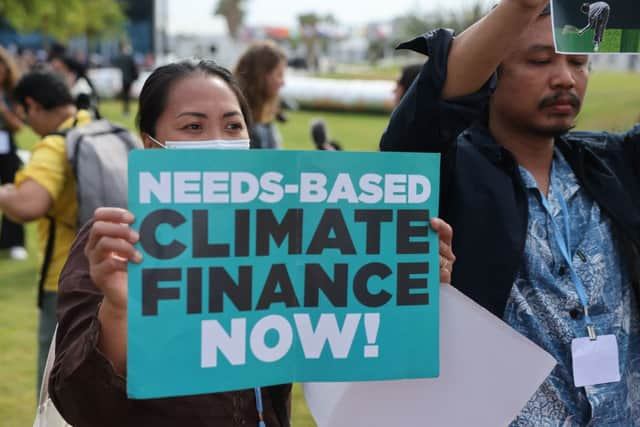COP27 outcomes: 4 key points from 2022 climate change summit - from loss and damage fund to carbon emissions
and live on Freeview channel 276
The COP27 conference in Sharm El-Sheikh, Egypt drew to a close on Sunday (20 November) after two weeks of negotiations.
The first major international climate change event since COP26 in Glasgow in 2021, the conference came against the backdrop of a worsening picture for planet earth.
Advertisement
Hide AdAdvertisement
Hide AdA summer of record temperatures across Europe, recent major flooding in Pakistan, and the continuing environmental impact of the war in Ukraine were all up for discussion at the summit.
While some progress was made - including an agreement to set up of a loss and damage fund - the event is likely to go down in history as yet another missed opportunity to save the world from catastrophe.
So, what were the big takeaways from COP27? Here’s NationalWorld’s take on the key events at the Egyptian conference.


Loss and damage fund
Arguably the biggest bit of progress in Egypt came from a last-minute agreement to set up a fund to help developing nations recover from the impacts of climate change.
Advertisement
Hide AdAdvertisement
Hide AdSince COP events began in the mid-1990s, many of the world’s poorest countries have sought money from the richest nations to help them rebuild infrastructure that’s been damaged by extreme weather and other climate events, like rising sea levels.
They argue that much of the blame for the global crisis comes from the CO2 emitted by nations, like the UK, whose prosperity was built on the burning of fossil fuels. UN research has shown that the 46 least-developed countries - which are home to 1.1 billion people - were responsible for just 1.1% of all emissions in 2019.
The EU and the USA provided the biggest opposition to the fund. They only agreed to u-turn so long as some countries still classed as developing, but who are responsible for a big chunk of global emissions - like China - would also chip in. They also wanted to see the fund prioritise those most vulnerable to climate change.
Greenpeace described the deal as a “new dawn for climate justice”, while Oxfam said it was a “monumental achievement” that “must be operationalised
Advertisement
Hide AdAdvertisement
Hide AdBut while the idea has been given the green light, the fund still needs to be launched and filled with cash. The world also needs to agree on how much money should be paid into this new pot, and where these funds should come from.
As well as the loss and damage fund, countries discussed reforming the World Bank to ensure more funds can be accessed by countries struggling to cope with climate change. Increased funding for boosting vulnerable countries’ resilience to climate change - a legacy from COP26 - was also reaffirmed.


The ratchet mechanism
The ratchet mechanism is a requirement for countries to regularly revise and communicate their emissions targets - known as nationally determined contributions (NDCs) - in a bid to ensure the world is on course for heating of no more than 1.5℃.
It was introduced as part of the Paris Climate Agreement in 2015 - initially as part of a 2℃ goal - but had a big revision at COP26 as science showed 2℃ was unsafe.
Advertisement
Hide AdAdvertisement
Hide AdThe 1.5℃ goal and the ratchet both had their futures openly questioned at COP27, but managed to survive - a pivotal moment in the battle against climate change. However, a resolution for the world to hit peak emissions by 2025 was scrapped, which has been viewed as a step backwards.


Phasing out fossil fuels
At COP26, in what was seen as the biggest achievement of the Glasgow event, countries agreed to phase out the use of coal.
While some countries, including India, tried to go further at COP27 - calling for a target for all nations to sign up to specific targets for lowering their usage of fossil fuels - it failed at the last minute.
It means the Glasgow commitment on coal continues to be the only reference to phasing out fossil fuels that has been agreed at a COP - something that suggests the world is no closer to a big breakthrough on tackling the root causes of climate change.


Advertisement
Hide AdAdvertisement
Hide AdMeanwhile, a provision in the conference’s final text to boost “low-emissions energy” could be interpreted to mean nations could ramp up their burning of natural gas - less of an emitter than coal, but a fossil fuel nonetheless.
Tipping points
A minor victory secured at COP27 was the acknowledgement of ‘tipping points’ in the final text that came out of the negotiations.
It means countries now accept that the world’s climate does not increase in a linear way, but rather hits certain points that can accelerate the heating of the planet. For example, if enough of the Amazon rainforest is destroyed, scientists believe its weather cycles could see it change from being a carbon sink to an emitter.
As well as accepting the existence of tipping points, the nations also agreed that humans have “the right to a clean, healthy and sustainable environment”.
Comment Guidelines
National World encourages reader discussion on our stories. User feedback, insights and back-and-forth exchanges add a rich layer of context to reporting. Please review our Community Guidelines before commenting.
